XFX’s Radeon HD 7970 Black Edition Double Dissipation: The First Semi-Custom 7970
by Ryan Smith on January 9, 2012 6:00 AM ESTOverclocking
Though XFX does not provide any overclocking tools for the BEDD, the card itself is advertised as an overclocking card to an extent. The use of the AMD PCB and a similarly high performing cooler means that overclocking results shouldn’t be much better or much worse than reference cards, but given how much potential we’re seeing out of the 7970 this is not a bad thing.
Even with XFX’s factory overclock the BEDD features the same 1125MHz overdrive limit as all current 7970 cards, so you have 125MHz (~11%) to play with within Overdrive. Based on our experience this is right at the edge of what’s this card is capable of – after pushing the card to 1150MHz through MSI’s Afterburner software we found that our sample peaked at 1125MHz anyhow, as anything beyond that impacted stability and caused artifacts. Meanwhile we were able to push our memory to 6.3GHz, as beyond that point performance plateaued as the need for error correction nullified our gains.
Our final clocks were 1125MHz core and 6.3GHz memory, representing a 21% core and 14% memory overclock over the reference 7970, or an 11% core and 11% memory overclock over XFX’s factory overclock. As the BEDD uses an AMD PCB it should be possible to use compatible voltage tweaking software to push it further, but for the time being we’re limiting ourselves to what the 7970 can do on stock voltage as the AMD PCB isn’t particularly overbuilt for overvolting. On that note we did increase our PowerTune limit to +20% (300W) in order to ensure PowerTune didn’t throttle our overclocked BEDD, though there appears to be headroom to spare in at least some of our games.
| Radeon HD 7970 Overclocking | |||||
| Radeon HD 7970 Stock | XFX Radeon HD 7970 BEDD | XFX Radeon HD 7970 BEDD Overclock | |||
| Core Clock | 925MHz | 1000MHz | 1125MHz | ||
| Memory Clock | 1.375GHz (5.5GHz effective) GDDR5 | 1.425GHz (5.7GHz effective) GDDR5 | 1.575GHz (6.3GHz effective) GDDR5 | ||
| Voltage | 1.17v | 1.17v | 1.17v | ||
| PowerTune | 250W | 250W | 300W | ||
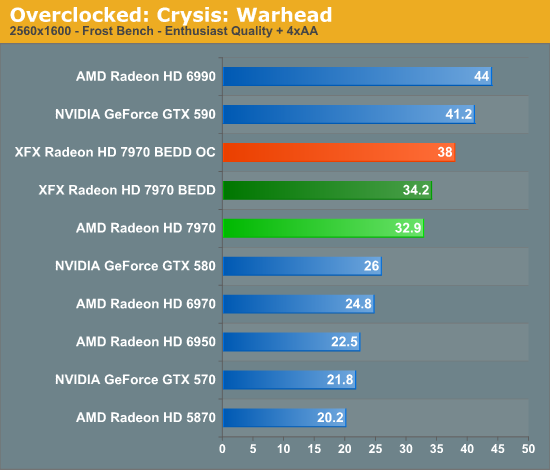


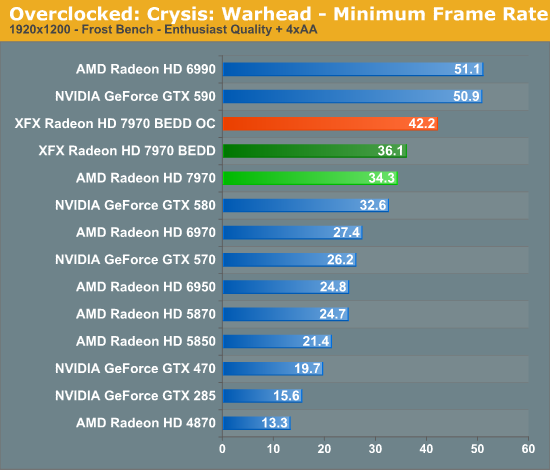
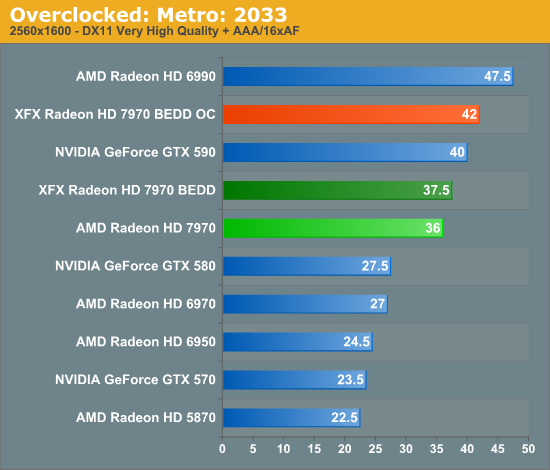

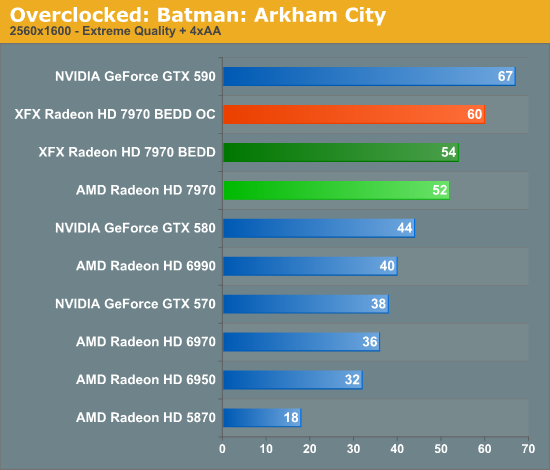
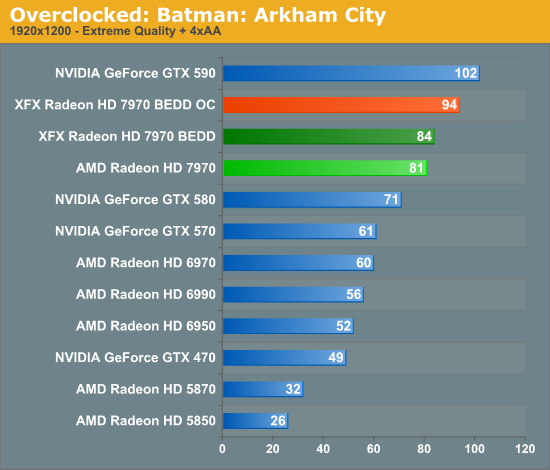
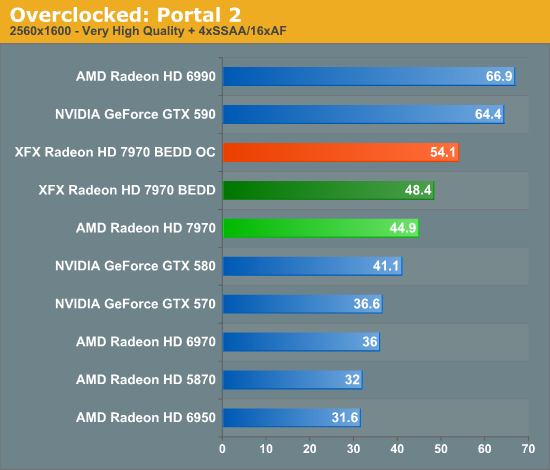
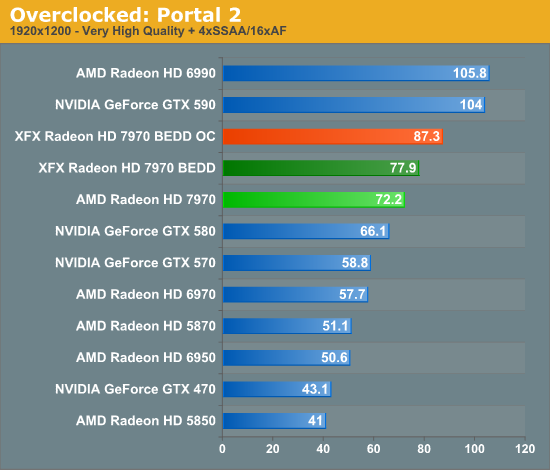
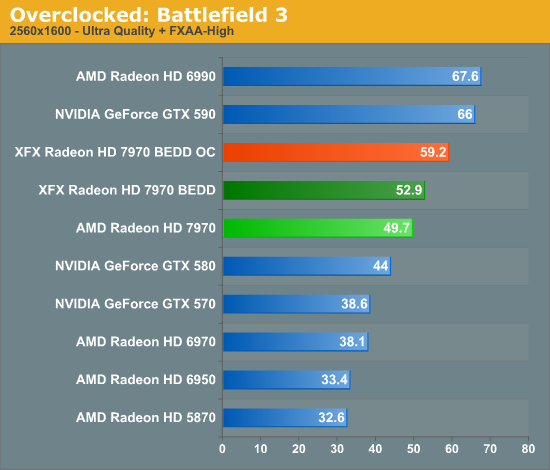
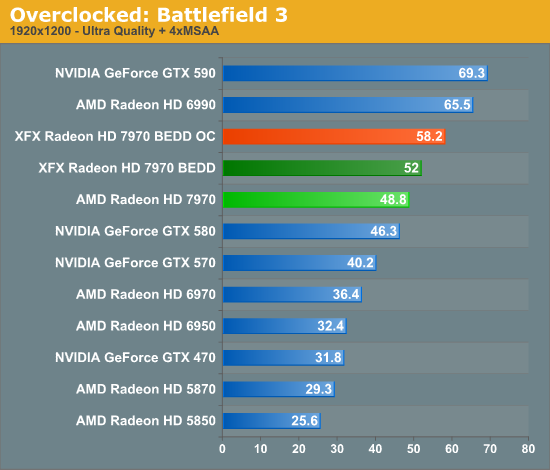
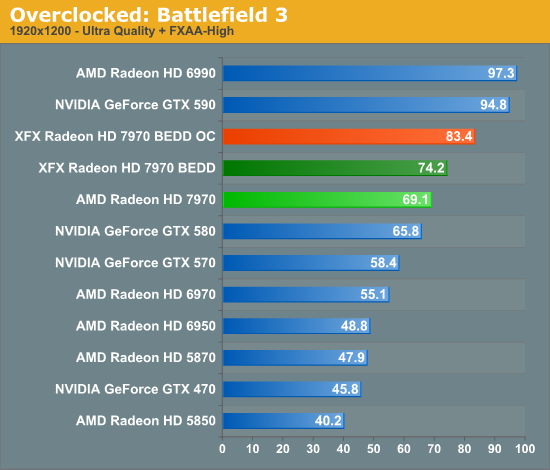
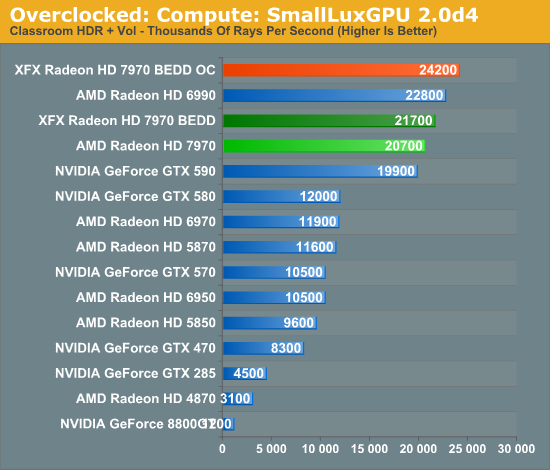
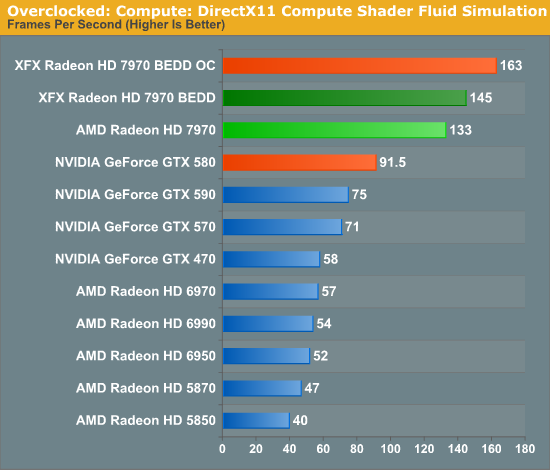
The end result of a further 11% overclock to both the GPU and memory clock results in a very consistent 11% performance increase across the board. From Crysis to Battlefield 3 everything jumps up by 11%, and the combination of the two overclocks means that our overclocked BEDD leaves just about every other single-GPU video card in the dust. Even the dual-GPU 6990 and GTX 590 have their leads seriously eroded, and in a few cases the overclocked BEDD will pull ahead of the GTX 590 in games that AMD does particularly well in. If the reference 7970 and BEDD didn’t impress you, certainly this will.
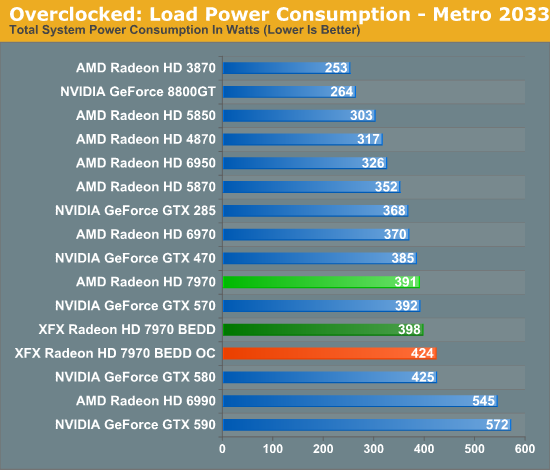
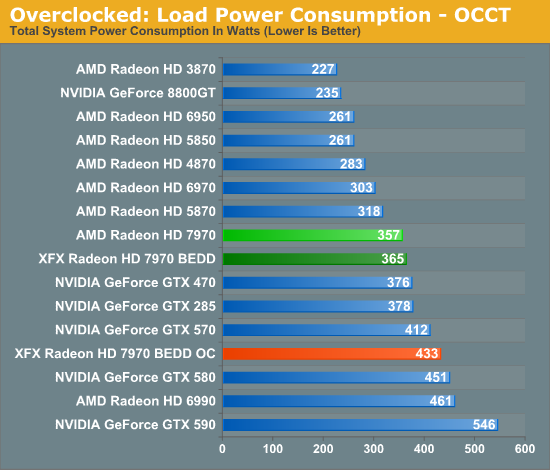
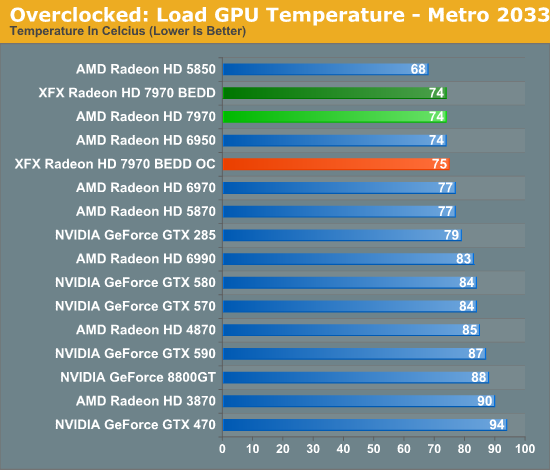
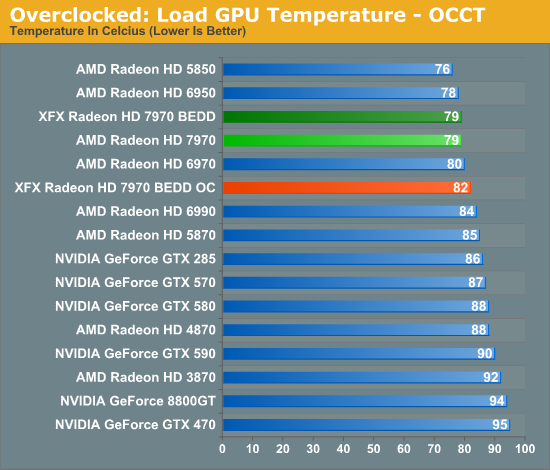
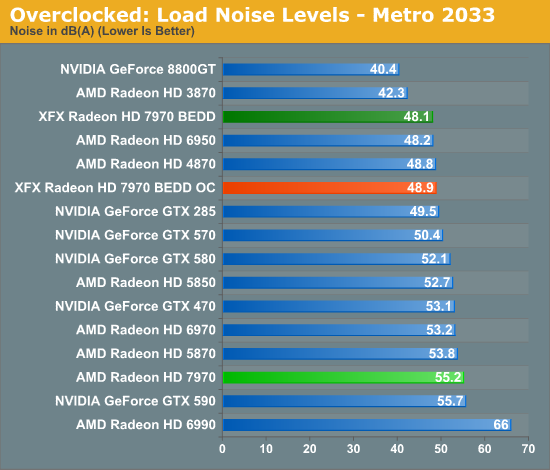
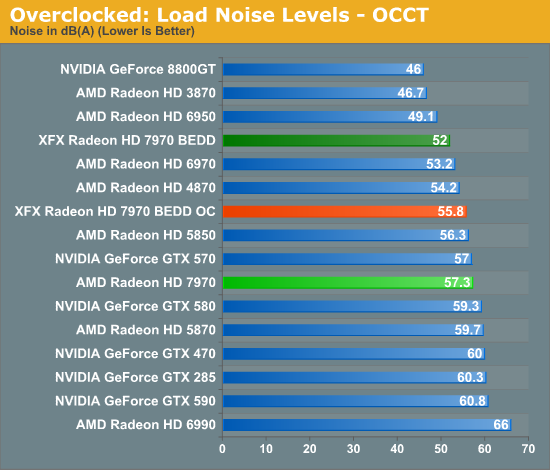
So what’s the tradeoff for this overclock? It’s actually very little. Even with our increased PowerTune limit – which doesn’t increase the power consumption, just the potential for power consumption – power consumption under Metro only rises 26W, and at least some of this will be additional work on the CPU in response to the relaxed GPU bottleneck. OCCT looks worse, but again this has more to do with the PowerTune limit than the overclock.
The fact that this overclock has had a minimal impact on the power consumption of our BEDD is reinforced by our temperature and noise data. Under Metro the overclocked BEDD gets 1C warmer and 2dB louder versus its factory clocks, which is a very small increase given the 11% overclock. So long as we don’t touch the core voltage for the BEDD (or any other 7970), the power tradeoff for overclocking is nearly non-existent, which is fantastic news given that we’ve just driven a 7970 21% over AMD’s reference clocks on reference voltage.










93 Comments
View All Comments
Death666Angel - Monday, January 9, 2012 - link
You should read the launch article. But in case you won't:"At the 7970’s core clock of 925MHz this puts Tahiti’s theoretical FP32 compute performance at 3.79TFLOPs, while its FP64 performance is ¼ that at 947GFLOPs. As GCN’s FP64 performance can be configured for 1/16, ¼, or ½ its FP32 performance it’s not clear at this time whether the 7970’s ¼ rate was a hardware design decision for Tahiti or a software cap that’s specific to the 7970. However as it’s obvious that Tahiti is destined to end up in a FireStream card we will no doubt find out soon enough."
R3MF - Wednesday, January 11, 2012 - link
many thanks, must have missed that first time around.cyrusfox - Monday, January 9, 2012 - link
Its great that you still include Starcraft 2 results, you're about the only site that still constantly includes that game, and as that game has odd issues on amd cpus and gpus, its good to know this card still scales well on that game. Appreciate that you still bench it Ryan. Thanksgeniekid - Monday, January 9, 2012 - link
++I understand that FPSes are usually the most graphically taxing games, but SC2 and Civ 5 show that there are other genres that take advantage of graphical processing power. Plus, it's always nice to see benchmarks for games I actually play :)
vol7ron - Monday, January 9, 2012 - link
Agreed for all the above.I used to love that Counter Strike was included in all the benchmarks. Realizing that game no longer saw any true benefit from a new GPU some odd years ago; but it was nice to see in the charts here on AT for posterity. BTW, I think Steam is developing a new engine for CS; maybe AT would like to do some reviews of software version differences.
chizow - Monday, January 9, 2012 - link
AMD and its fans can't really claim they're the champions of the poor and downtrodden budget enthusiast anymore with the 7970's pricing. I mean the pricing looks OK compared to last-gen parts as of today, but I don't think that's going to be the case when Nvidia releases their Kepler parts in the next few months.Nvidia has a great opportunity with Kepler to do what AMD did to them a few years ago with Cypress....which is make the opposition look really bad with regard to pricing and win back some of that mindshare and goodwill AMD has built up over the years. If the high-end Kepler part ends up 15-20% faster than the 7970 as many expect and is priced at $500 like the last 2 Nvidia flagship single-GPU parts, I wonder if AMD will be the one issuing rebate checks?
I always considered the 4870 a pricing mistake on AMD's part where they failed to capitalize on a successful part. What's clear is that AMD also realized their mistake and have made steps to correct their pricing over the years:
4870 $299
5870 $379 (raised to ~$430)
6970 $369
7970 $549!!!
In the past, even when ATI was running 2nd for the generation behind Nvidia, they provided users value at a price point that made sense against that generation's competitor parts. I don't think that will hold true in this case when Kepler is finally released, and AMD will have to suffer those consquences (similar to Nvidia and GT200).
Will be fun to see how it shakes out either way, but its good to see AMD trying to make a buck or two and put the charitable spin to rest for good.
SlyNine - Monday, January 9, 2012 - link
I'm really hoping they lower the price.I bought 2 8800GTs 512 (when it first came out) and the 5870 when it first came out. I knew both those cards values were over the top. Proven by the fact that the cost went up soon after I bought them.
My point is there can be value at the very high end, the 5870 is proof of that. This card can not touch what the 5870, 4870, 9700pro, 8800GT was in value at the time of release. If this card is the card that made them switch to AMD then they were not paying attention.
Morg. - Tuesday, January 10, 2012 - link
They will lower the price, because nVidia will try to compete.They're just taking advantage of the current position of the 7970 : first 28nm gpu.
chizow - Tuesday, January 10, 2012 - link
Well I think those are all valid case points and extremely impressive parts, but the reality of it is, the 5870's pricing was just a result of the fallout from the 4870.If you look back, as fast as the 5870 was, it was still in a similar position as the 7970 is today, only 15-25% faster than the GTX 285. The GTX 285 launched at only $380 as a die-shrink refresh of the 280. All prices around that time were badly deflated due to price wars, the economy, but most importantly, the 4870's pricing. So when the 5870 launched at the end of 2009, they couldn't price it any higher at first, but once it became clear Nvidia didn't have a 40nm response in 2009, they quickly jacked up the price.
Overall though I think value just depends on where you are in the upgrade cycle with either Nvidia or AMD and how much of an improvement you need to see before you upgrade. If you're with Nvidia right now with a 480/580, the 7970 doesn't really look all that great for 15-25% more performance at $550. It makes more sense to wait for Kepler for that expected 50% increase at roughly the same price point.
But it might be worth it for an AMD user who's going to see 50%+ gains from a 6970/5870. Still, one has to wonder if that performance is worth it for such a huge increase in price, which again, is the position AMD has put itself in based on their historical pricing.
Morg. - Tuesday, January 10, 2012 - link
The 15-25% performance is wrong.drivers are beta at best
resolution reviewed are typically where the 580 shines
the 6970 was about 5% worse than a 580 above full HD . don't know where you get 50% but that's great for you.
No top card ever looked great at its top card price. that's not the point of the top card.